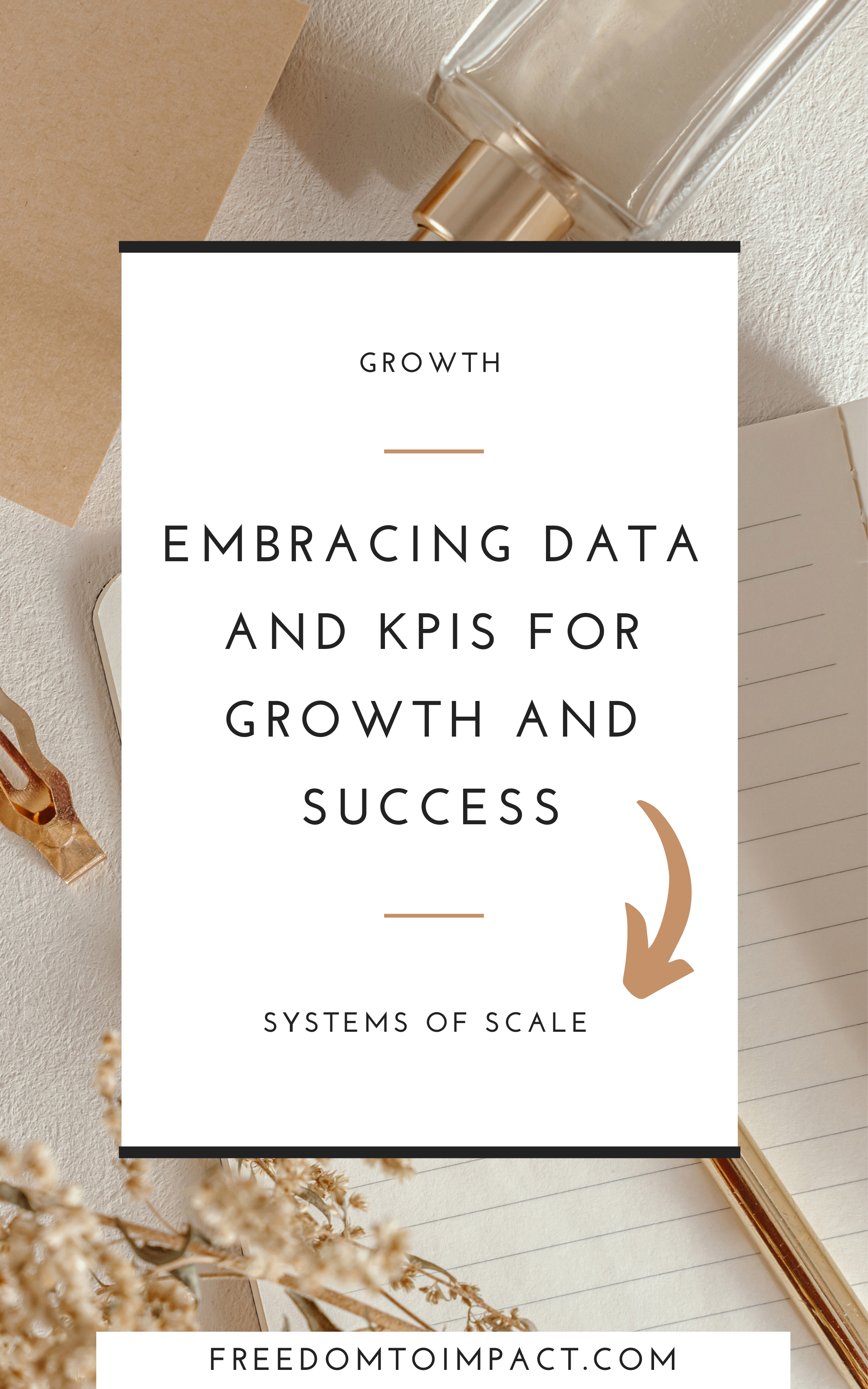Elevate Your Business: Embracing Data and KPIs for Growth and Success
Running a business, juggling all those balls in the air, can feel a bit like trying to herding cats. You've got a lot on your plate, and we totally get it. But here's the secret sauce that's going to take your business game to the next level: data and Key Performance Indicators (KPIs).
Now, before you go "Oh no, more jargon!" Let us tell you – it's not as complex as it sounds. You're already using data and KPIs in your everyday life. Like when you try to beat your step count on your fitness tracker? That's a KPI right there!
So, why not apply the same principle to your business? Trust us, embracing data and KPIs doesn't have to be overwhelming or complicated. It's all about getting insights into what's working for your business, what isn't, and figuring out how to make the good stuff happen more often.
So, let's take this journey together! We'll dive into the world of data and KPIs, learn about the most common ones, and figure out how to weave them into your daily business hustle. It's all about using facts and figures to make your decision-making process as smooth as silk.
Understanding the Significance of Data and KPIs
Data: Fueling Informed Decisions
Imagine data as the fuel that drives your informed decision-making. It encompasses information and facts collected, analyzed, and interpreted to gain insights into your business. By tapping into the power of data, you gain a deeper understanding of your business and make decisions based on concrete evidence.
KPIs: Navigating Success
Think of Key Performance Indicators (KPIs) as your business's compass, guiding you towards success. These measurable values reflect your business's performance and health. By setting clear KPIs and tracking them regularly, you gain valuable insights into your progress and can make data-driven decisions that propel your business forward.
Advantages of Data and KPIs
Objectivity in Decision Making
Data and KPIs provide an objective foundation for decision making, removing biases and personal opinions from the equation. By relying on factual information and measurable metrics, you can make informed choices based on concrete evidence rather than gut feelings. Objectivity leads to more rational decision making, minimizing the potential for errors or misguided judgment.
2. Reduced Risks and Increased Confidence
Guesswork and assumptions can be risky in business. By using data and KPIs, you minimize the risks associated with making decisions based on incomplete or inaccurate information. Data-driven decision making allows you to assess risks and potential outcomes more accurately, increasing your confidence in the choices you make. With a solid foundation of data, you can mitigate potential pitfalls and make more calculated moves that align with your business objectives.
3. Measurable Progress and Continuous Improvement
Data and KPIs offer a quantifiable way to measure progress and track the performance of your business. By setting specific KPIs and monitoring them regularly, you can evaluate your business's growth and success objectively. Data-driven decision making enables you to identify areas for improvement, allocate resources strategically, and make necessary adjustments to stay on track towards your goals.
4. Foster a Culture of Accountability
When data and KPIs become the basis of decision making, a culture of accountability is fostered within your organization. With clear metrics and performance indicators in place, individuals and teams take ownership of their responsibilities and strive to achieve targets. Regular monitoring and reporting of KPIs create transparency, encouraging accountability and driving a sense of collective responsibility for the business's success.
Identifying Key Metrics for Business Success
Clear Business Goals: The North Star of Decision Making
Clear business goals and objectives provide the foundation for data-driven decision making. By defining your goals, such as revenue growth or customer satisfaction, you can align your KPIs accordingly. This ensures that your decisions are purposeful and contribute directly to your business's success.
Relevant KPIs: Measuring What Matters
Identifying relevant KPIs is crucial for measuring progress towards your goals. Sales, marketing, and customer satisfaction all have different metrics. For example, in sales, you might track conversion rates or average order value. In marketing, it could be website traffic or social media engagement. Choose KPIs that provide meaningful insights into the areas of your business that matter most.
Common KPI Examples: Insights into Success
Sales KPIs:
Revenue Growth - Measure the percentage increase in revenue over a specific period. Provides insights into the effectiveness of sales strategies and overall business performance.
Customer Acquisition Cost (CAC) - Determine the cost incurred to acquire a new customer. Helps evaluate the efficiency of marketing and sales efforts in generating new leads and converting them into customers.
2. Marketing KPIs:
Website Traffic - Monitor the number of visitors to your website. Indicates the effectiveness of your marketing campaigns and the reach of your online presence.
Return on Investment (ROI) for Campaigns - Calculate the profitability of marketing campaigns by comparing the investment made to the revenue generated. Assesses the success of specific marketing initiatives and guides future investment decisions.
3. Customer Satisfaction KPIs:
Net Promoter Score (NPS) - Measure customer loyalty and satisfaction by asking them to rate the likelihood of recommending your business to others. Helps assess the overall customer experience and identify areas for improvement.
Retention Rate - Track the percentage of customers who continue to do business with your company over a given period. Indicates the effectiveness of your products, services, and customer support in fostering loyalty.
4. Operational KPIs:
Order Fulfillment Cycle Time - Measure the time taken to process and fulfill customer orders. Assesses operational efficiency and customer satisfaction with the order fulfillment process.
Employee Productivity - Track the output and performance of employees in relation to their assigned tasks and responsibilities. Provides insights into workforce efficiency and helps identify areas for optimization.
5. Financial KPIs:
Gross Profit Margin - Calculate the percentage of revenue that remains after deducting the cost of goods sold. Indicates the profitability of your products or services.
Cash Flow - Track the movement of cash into and out of your business over a specific period. Helps ensure sufficient liquidity and financial stability.
Gathering and Analyzing Data
Methods of Data Collection: Insights at Your Fingertips
Data collection methods like surveys, customer feedback, website analytics, and market research provide valuable insights. Surveys gather specific information, feedback unveils preferences, analytics reveal user behavior, and market research uncovers industry trends. By utilizing these methods, you tap into a wealth of insights to guide your decision-making.
Data Accuracy, Reliability, and Relevance
Data must be accurate, reliable, and relevant. Accuracy ensures error-free information, reliability guarantees consistent collection, and relevance aligns data with your goals. Prioritizing data quality enables confident decision making based on reliable and meaningful information.
Data Visualization: Unveiling Insights
Data visualization tools simplify complex data sets into visual representations like charts and graphs. They help spot trends, patterns, and correlations at a glance, making it easier to identify key insights. By leveraging data visualization, you unlock the power of visual storytelling and gain a deeper understanding.
Effective Data Analysis and Interpretation
Effective data analysis involves defining objectives, using appropriate techniques, identifying outliers, considering external factors, and deriving actionable insights. A systematic approach ensures meaningful patterns and trends are uncovered, leading to informed decision making and goal refinement.
Leveraging Data and KPIs in Decision Making
Data-Driven Insights: Seizing Opportunities, Fueling Growth
Data-driven insights play a pivotal role in identifying business opportunities and areas for improvement. By analyzing data, you can uncover hidden patterns, customer preferences, and market trends that may otherwise go unnoticed. These insights enable you to seize opportunities, adapt to changing demands, and fuel the growth of your business.
KPIs: Guiding Actions, Optimizing Resources
KPIs act as guiding beacons in decision making, helping you prioritize actions and allocate resources efficiently. By tracking key metrics, you gain a clear understanding of what's working and what needs improvement. KPIs provide a tangible way to measure progress, ensuring that your efforts are focused on the most impactful areas and optimizing the allocation of your valuable resources.
Translating Insights into Actionable Strategies
Translating data-driven insights into actionable strategies and initiatives is a crucial step in harnessing the power of data and KPIs. It involves analyzing the insights gained from data, identifying trends, and deriving actionable steps that align with your business objectives. By bridging the gap between insights and action, you can turn data into tangible strategies that drive positive outcomes and propel your business forward.
Overcoming Challenges and Maximizing the Benefits
Challenges of Implementing Data-Driven Decision Making
As busy women entrepreneurs, we often face common challenges when implementing data-driven decision making. We may have limited time and resources for data analysis, a lack of data literacy or technical skills, and difficulty in identifying the most relevant data sources. Recognizing and addressing these challenges is crucial to fully harnessing the power of data in driving business success.
Strategies for Integrating Data and KPIs into Daily Operations
Foster a Data-Driven Culture
To foster a data-driven culture within your organization, it's important to communicate the importance of data. Educate your team about the value and benefits of data-driven decision making. Emphasize how data can drive business growth, improve decision outcomes, and enhance overall performance. Lead by example by incorporating data into your own decision making. Encourage and reward employees who embrace data-driven approaches and showcase successful outcomes.
Enhance Data Literacy
To enhance data literacy among your team, provide training programs and workshops. Teach them how to collect, interpret, and analyze data effectively. Encourage learning and skill development by fostering a continuous learning environment. Provide access to resources such as online courses, webinars, and industry publications.
Establish Data Collection and Analysis Processes
To enhance data literacy among your team, provide training programs and workshops. Teach them how to collect, interpret, and analyze data effectively. Encourage learning and skill development by fostering a continuous learning environment. Provide access to resources such as online courses, webinars, and industry publications.
Implement Reporting and Visualization
Design customized dashboards that present key data and KPIs in a clear and intuitive manner. Tailor the dashboards to meet the specific needs of different teams or departments within your organization. Establish a regular reporting schedule to review and discuss the performance metrics and KPIs. Encourage open discussions to analyze trends, identify patterns, and make data-driven decisions.
Continuously Improve and Refine
Regularly monitor and evaluate the effectiveness of data-driven decision-making processes. Assess the impact of integrating data and KPIs into daily operations on business outcomes. Learn from the insights gained through data analysis and adjust strategies and processes accordingly. Continuously refine and improve your data-driven practices to maximize their impact on business success.
Embrace Data and KPIs: Ignite Your Business's Success
In a world driven by data, harnessing its power becomes imperative for business success. As multitaskers, we understand the importance of making informed decisions amidst multiple responsibilities. By utilizing data-driven decision making and embracing the guidance of Key Performance Indicators (KPIs), we can navigate the challenges, seize opportunities, and fuel the growth of our businesses. With data as our fuel and KPIs as our compass, we gain a deeper understanding of our businesses, make informed decisions, and optimize our resources.
It’s time to stop feeling like we are walking around in a fog when it comes to making decisions about our businesses. Let's unlock the full potential of our businesses by embracing the power of data and KPIs, and witness how they propel us towards unprecedented growth, success, and accomplishment. The path to data-driven success awaits – are you ready to embark on this transformative journey?
Our Systems of Scale program is the perfect next step. Let's put this knowledge to work, streamline your systems, and start measuring your KPIs!



